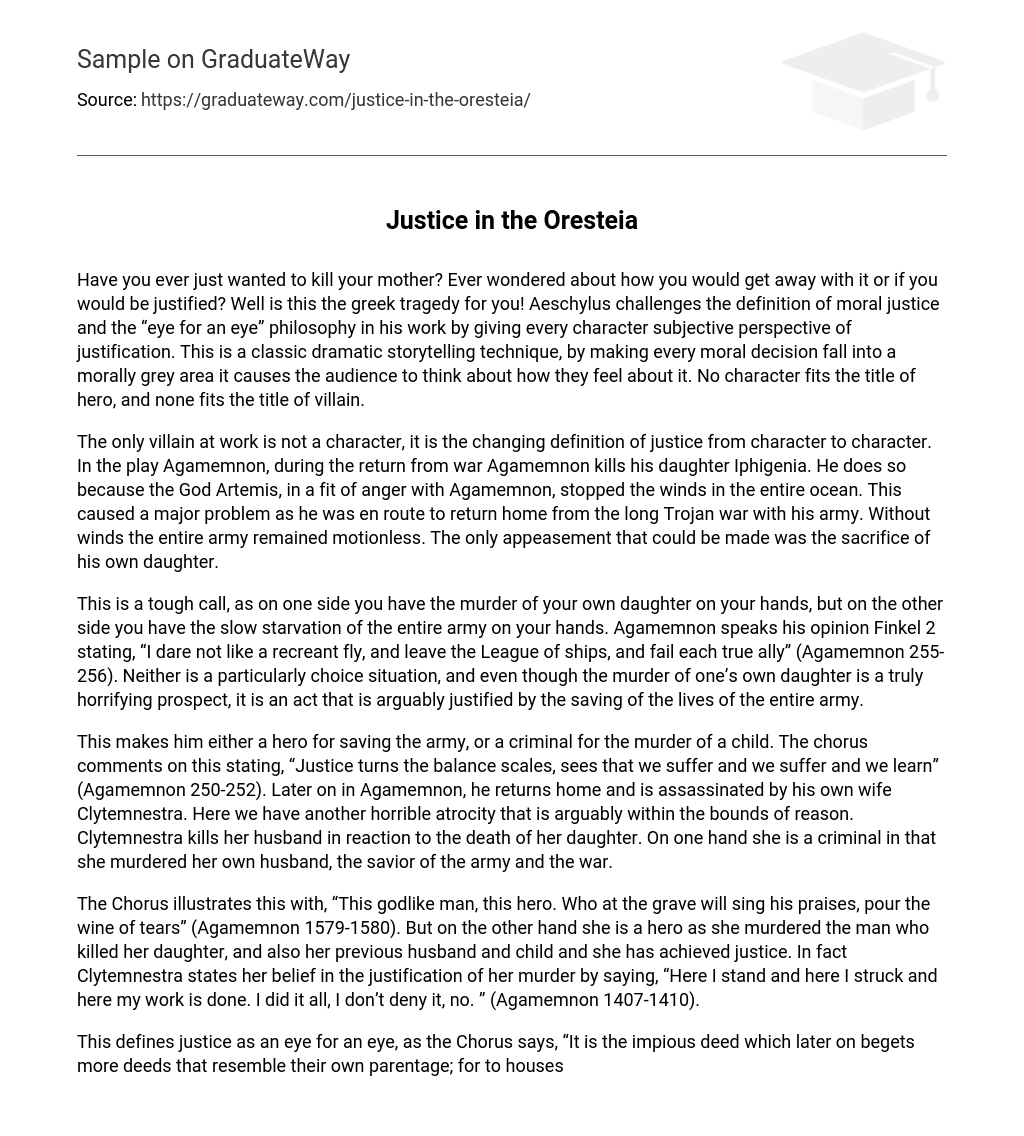Have you ever just wanted to kill your mother? Ever wondered about how you would get away with it or if you would be justified? Well is this the greek tragedy for you! Aeschylus challenges the definition of moral justice and the “eye for an eye” philosophy in his work by giving every character subjective perspective of justification. This is a classic dramatic storytelling technique, by making every moral decision fall into a morally grey area it causes the audience to think about how they feel about it. No character fits the title of hero, and none fits the title of villain.
The only villain at work is not a character, it is the changing definition of justice from character to character. In the play Agamemnon, during the return from war Agamemnon kills his daughter Iphigenia. He does so because the God Artemis, in a fit of anger with Agamemnon, stopped the winds in the entire ocean. This caused a major problem as he was en route to return home from the long Trojan war with his army. Without winds the entire army remained motionless. The only appeasement that could be made was the sacrifice of his own daughter.
This is a tough call, as on one side you have the murder of your own daughter on your hands, but on the other side you have the slow starvation of the entire army on your hands. Agamemnon speaks his opinion Finkel 2 stating, “I dare not like a recreant fly, and leave the League of ships, and fail each true ally” (Agamemnon 255-256). Neither is a particularly choice situation, and even though the murder of one’s own daughter is a truly horrifying prospect, it is an act that is arguably justified by the saving of the lives of the entire army.
This makes him either a hero for saving the army, or a criminal for the murder of a child. The chorus comments on this stating, “Justice turns the balance scales, sees that we suffer and we suffer and we learn” (Agamemnon 250-252). Later on in Agamemnon, he returns home and is assassinated by his own wife Clytemnestra. Here we have another horrible atrocity that is arguably within the bounds of reason. Clytemnestra kills her husband in reaction to the death of her daughter. On one hand she is a criminal in that she murdered her own husband, the savior of the army and the war.
The Chorus illustrates this with, “This godlike man, this hero. Who at the grave will sing his praises, pour the wine of tears” (Agamemnon 1579-1580). But on the other hand she is a hero as she murdered the man who killed her daughter, and also her previous husband and child and she has achieved justice. In fact Clytemnestra states her belief in the justification of her murder by saying, “Here I stand and here I struck and here my work is done. I did it all, I don’t deny it, no. ” (Agamemnon 1407-1410).
This defines justice as an eye for an eye, as the Chorus says, “It is the impious deed which later on begets more deeds that resemble their own parentage; for to houses upright and just fine children are destined forever” (Agamemnon 750-762). From her perspective she has achieved justice, just as Agamemnon did. Finkel 3 In the Oresteia’s second chapter The Libation Bearers, Orestes kills his mother Clytemnestra. An important aspect in this murder is another intervention by the Gods. This time, Apollo threatens Orestes with leprosy or further exile if he does not return and exact vengeance.
The two opposing sides here are that it can be viewed as he murdered his own mother to selfishly avoid his own death, or that he avenged his father and achieved justice. Once again the chorus speaks their mind on the subject, egging on Orestes with, “Certainly there is a law that bloodshed dripping to the ground demands another’s blood” (Libation Bearers 402-404). From Orestes perspective he has also achieved justice, the same way that Clytemnestra and Agamemnon did. Justice has been murder justified by murder three times in this story, and it would have been four had the Furies not been stopped.
This begs the question, did anyone achieve justice? In the final chapter Orestes is put on trial and is held not guilty for his actions. This means that Orestes achieved justice through murder, just as Agamemnon and Clytemnestra achieved “justice. ” Would the murder of Orestes be equally justified? If this is correct, then by the philosophy of “an eye for an eye” it would leave the whole world blind. The cycle only ends because the Furies are tamed by the Gods after the trial. Is there no way to achieve justice without a recurring cycle of violence?
The story was able to do so by a holding a trial, is this something we should consider? These are tough questions that Aeschylus puts in front of his audience within the drama of the Oresteia, the purpose of which is to redefine the nature justice, and separate it from the “eye for an eye” philosophy.
Work Cited
Aeschylus. “Agamemnon. ” The Oresteia. Trans. Robert Fagles. New York: Penguin Group, 1979. 1429-441. Print. Aeschylus. “The Libation Bearers. ” The Oresteia. Trans. Robert Fagles. New York:Penguin Group, 1979. 887-88. Print.





